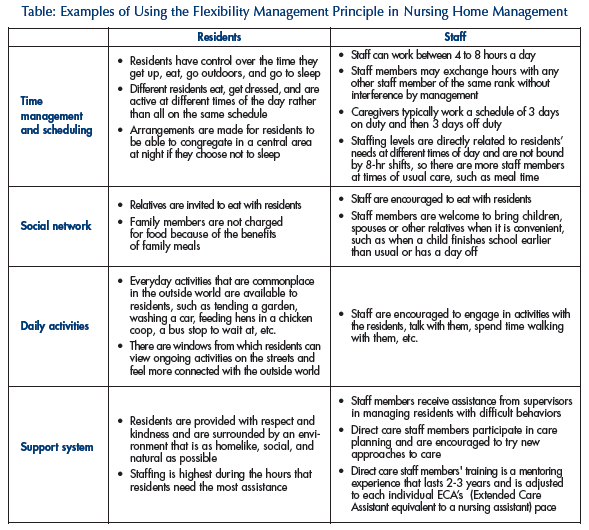Q & A With the Expert on: Nursing Home Management
Q: What is the flexibility management principle in long-term care?
A: The flexibility management principle asserts that flexibility is a necessary component of the way in which management deals with residents and staff members in long-term care. With respect to residents, the process of providing quality care includes trying to understand the person with dementia and fulfilling the needs of that person, as well as trying to create an environment that compensates for the cognitive, sensory, and physical losses the person experiences.1 Thus, the care environment needs to be flexible to meet the needs of each specific person and provide that person with a nurturing environment.
Adards [Alzheimer’s Disease and Related Disorders] Nursing Home in Tasmania, Australia, provides an example of some of the ways in which a nursing home can exercise flexibility to promote person-centered care.2 As has been mentioned, in order to have staff members provide compassionate care, administration needs to treat staff members with compassion and respect as well.3 Flexibility, therefore, needs to be practiced in approaching residents and staff members alike. Adards developed a framework that allows flexibility towards staff members and residents in a way that maximizes both staff satisfaction and institutional efficiency. Examples of the ways in which flexibility is practiced in Adards are summarized in the Table.

Flexible staff policies allow Adards to veer away from traditionally rigid scheduling requirements and allow staff to adapt their schedules to life events that arise. For example, if a staff member’s child has a half-day at school, he or she is permitted to bring the child to work. In addition, workers are not bound by 8-hour shifts, but can work between 4-8 hours at a time and swap shifts with a coworker (with the authorization of the registered nurse) if a scheduling conflict or unforeseen event occurs. Residents also have greater independence and create their own daily agendas without being forced to participate in specific activities or eat meals at set times.2 Relatives and friends of both staff and residents are welcome and even encouraged to spend time at the nursing home (eg, eating meals together). Flexibility makes the transition from independent or assisted-living much smoother for residents, and it adapts to the home and family responsibilities of staff members. The atmosphere created by this type of management is summarized by the director of nursing, who remarked, “If, when I come into the unit in the morning, I see all the beds made and the residents all dressed, I am concerned. But if I see that not everything has been done, and that staff members are eating breakfast and joking with the residents, I know everything is fine.”2
Adards found a number of advantages to this approach, including:
• The ability to schedule higher staffing levels at the specific hours at which they are needed (eg, mealtimes) and lower staffing levels at other times
• Higher job satisfaction and lower turnover rate in comparison to other local nursing homes
• An atmosphere more similar to normal life, in which friends come and go, and share meals and their life experiences.
Although both the applicability of the examples to U.S. nursing homes and the impact of the experience on the nursing homes need to be evaluated, the examples presented may provide administrators with ideas by which they may enhance the level of flexibility in their institutions, with the hope of improving both residents’ and staff members’ quality of life.









